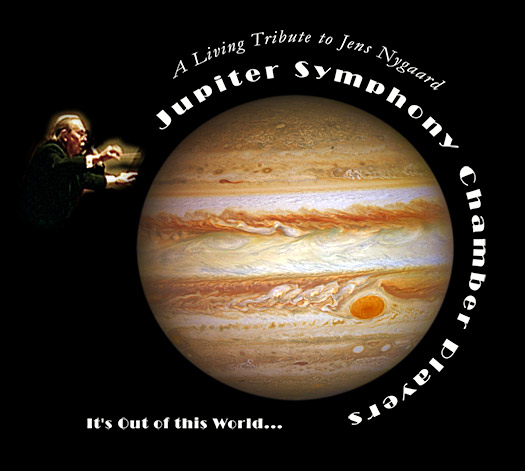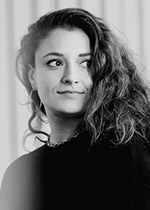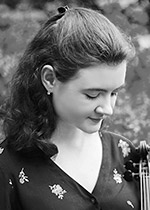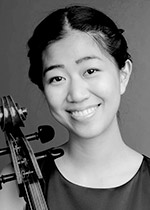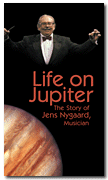Join us for our next concerts...
Monday, January 5 ♦ 2 PM & 7:30 PM
Out of Russia
Good Shepherd Presbyterian Church
152 West 66 Street (west of Broadway)
Limited Seating
Tickets: $25, $17 ~ Reservations advised
Call (212) 799-1259 or email admin@jupitersymphony.com
Pay by check or cash (exact change)
William Wolfram piano
Winner of the William Kapell, Naumburg, and Tchaikovsky competitions ~
“Wolfram’s technique is flabbergasting; fiendishly difficult octave
passages were as child’s play, and his strength is tempered by an easy
poetry.” The New York Times ~ “Wolfram is a dazzling performer.” Kalamazoo Gazette
Geneva Lewis violin
Recipient of the 2021 Avery Fisher Career Grant Grand Prize, 2020 Concert Artists Guild Competition, and Bronze Medal at the Fischoff competition as a member of the Callisto Trio
Hina Khuong-Huu violin
First-Prize winner of the 2023 Elmar Oliveira International Violin Competition, prizewinner of the 2018 Menuhin Competition held in Geneva, a recipient of the Salon De Virtuosi Career Grant ~Violin Channel’s “Rising Star”
Milena Pajaro-van de Stadt viola
Winnings include First Prize at the 2013 Banff Competition, Gold Medal and Grand Prize at the 2010 Fischoff Competition, First Prize at the Lionel Tertis Viola Competition, and top prizes at the Tokyo and Sphinx competitions ~ “she
should have a great future” Tully Potter ~ Wigmore Hall ~ “lyricism that stood out...a silky tone and beautiful, supple lines” Strad Magazine
Gaeun Kim cello
Among her honors are the 2023 New York Young Artist Award, first prize and Pablo Casals special award at the 2022 Irving Klein competition, first and audience prizes at the 2022 Washington competition, first prize at the 2015 David Popper and 2014 Liezen competitions, and first prize and special award at the 2012 Antonio Janigro Competition
Vadim Lando clarinet
Winner of the CMC Canada, Yale and Stonybrook competitions ~ “consistently
distinguished...vibrant, precise, virtuosic playing” The New York Times
TCHAIKOVSKY Valse–Scherzo Op. 34
~ colorful and vibrant, the duet for violin and piano sparkles with witty playfulness
Originally for violin and orchestra, the Valse–Scherzo was composed for and dedicated to violinist Yosif Kotek, whom Tchaikovsky had taught at the Moscow Conservatory and with whom he had an intimate relationship. Kotek noted that “this shall be a piece to impress everybody.” It has, and continues to do so. France hosted its first performance in conjunction with the Paris World Exposition on 20 September 1878 at a Russian Symphony Concert in Trocadero Hall, with the Polish violinist Stanisław Barcewicz as soloist and conductor Nikolai Rubinstein. The arrangement for violin and piano is by Tchaikovsky.
Aram KHACHATURIAN Trio
~ exotic, rhapsodic, hypnotic triowith lively cross rhythms and the use of Caucasian folk tunes—for clarinet, violin, and piano
An early work, the Trio was written at age 29 while at the Moscow Conservatory studying with Nikolai Myaskovsky. As it so happened, Prokofiev heard it in Myaskovsky’s composition class. He had rented an apartment in Moscow while still living in Paris, and was in the city to look for promising new compositions in the Soviet Union. In the interest of fostering cultural exchange between the Soviet Union and France, Prokofiev was given the task of promoting recent work of young Soviet composers abroad. Thus, through Prokofiev’s recommendation, the first performance of the Trio took place at the Société Triton in Paris. The Triton, dedicated to performances of new chamber music, was founded by the composer Pierre-Octave Ferroud in 1932. Prokofiev was one of the executive committee members, and the European premiere of his own Sonata for Two Violins was presented by Triton as well.
Khachaturian was one of the 3 top composers of the Soviet Union, and won 4 Stalin prizes, one Lenin prize, a USSR State Prize, and the title of “Hero of Socialist Labor.” Born in 1903 in Tbilisi, Georgia to an Armenian family, his first musical experiences were the folk songs of his mother and of his hometown—“I was brought up surrounded by rich folklore. This is how my way of thinking was born.” A late starter, his music education began at the age of 22 at the Gnessin State Musical and Pedagogical Institute and continued at the Moscow Conservatory, where he excelled in his studies (from 1951 he became a professor at both schools). As a young composer, he was influenced by Ravel, and later by the folk traditions of Armenia, Georgia, Russia, Turkey, and Azerbaijan. In 1948, along with Prokofiev and Shostakovich, Khachaturian was denounced under the Zhdanov Doctrine for bourgeois tendencies in his music. Forced to apologize publicly, his guilt was merely by association as his nationally-tinged musical idiom was a far cry from any modernistic excess. After Stalin’s death in 1953, he was the first among prominent musicians to appeal for fewer bureaucratic restraints and greater creative freedom. In 1954 he was named People’s Artist of the USSR. He composed in almost all genres and forms: ballets, concertos, symphonies, orchestral works, songs, film and incidental music, and pedagogical works. His most popular hit is the “Sabre Dance” from the ballet Gayane—recognizable worldwide. The New Grove Dictionary states that “Khachaturian’s successful career represents the fulfillment of a basic Soviet arts policy: the interpenetration of regional folklorism and the great Russian tradition. His native Armenian (and, in a wider sense, trans-Caucasian) heritage is reflected in his languid melodies, stirring rhythms and the pulsating vitality of his musical idiom; but his imagination was disciplined by an academicism based on Rimsky-Korsakov…. Whenever he used folklore he reshaped it in a personal way…. He represented socialist realism at its best.” Khachaturian died in Moscow in 1978, but is buried in Yerevan, Armenia.
Sergei PROKOFIEV Sonata in C Major for Two Violins Op. 56
~ piquant lycism
Upon hearing a poorly written work for two violins, Prokofiev produced his own Sonata as a commission piece to conclude the inaugural concert of Triton, a society in Paris dedicated to presenting new chamber music. The Sonata, in four movements of two-part counterpoint, is a mercurial mix of lyricism and sharp-edged rhythmic and harmonic piquancy, less dissonant than most of his works of the 1920s.
Sergey TANEYEV Piano Quintet in G minor Op. 30
~ cheerful, with unrivaled lyricism, as heartwarming as it is magnificent
The resplendent Quintet, as described by Cobbett’s Cyclopedic Survey of Chamber Music, is “The crowning glory of Taneyev’s chamber works with piano, permeated with profound thought and inward pathos.” Dark and densely textured, there is an abundance of soaring melodies and impassioned lyricism.
Taneyev (1856–1915) came from a cultured family with aristocratic connections. He was given his first piano lessons at age 5, and from the age of 9 to 18, he studied at the Moscow Conservatory. Among his teachers were Tchaikovsky (in composition) and Nikolai Rubinstein (in piano). He became a brilliant pianist, graduating in 1875 with a gold medal in composition and performance—the first in the history of the Conservatory to achieve this honor. Taneyev became close friends with Tchaikovsky and was held in such high regard that Tchaikovsky sought and appreciated his opinions and musical suggestions. He was trusted with giving the first Russian performance of Tchaikovsky’s First Piano Concerto as well as performing as soloist for the Russian premieres of Tchaikovsky’s other works for piano and orchestra. In 1878, upon Tchaikovsky’s resignation, Taneyev was persuaded to take his teacher’s place, but he consented only to teach the harmony and orchestration classes. In 1885 he reluctantly became the Conservatory’s director. Among his pupils were Rachmaninoff, Scriabin, Glière, Medtner, and Grechaninov. At his death from a heart attack in 1915, he left a large body of work including 4 symphonies, keyboard and choral works, and many chamber pieces. Taneyev has been called the “Russian Brahms” and he may also be a “Russian Bruckner.” Tchaikovsky had even dubbed him the “Russian Bach” (Bach was one of his early inspirations). |
|
Monday, January 19 ♦ 2 PM & 7:30 PM
Magyar Émigrés
Good Shepherd Presbyterian Church
152 West 66 Street (west of Broadway)
Limited Seating
Tickets: $25, $17 ~ Reservations advised
Call (212) 799-1259 or email admin@jupitersymphony.com
Pay by check or cash (exact change)
Albert Cano Smit piano
Winner in the 2019 Young Concert Artists Auditions, First Prize at the 2017 Naumburg Piano Competition and finalist and CMIM grant recipient of the 2017 Concours International Musical de Montréal ~ “a superb musician has spoken” Le Devoir
William Hagen violin
Third prize winner of the 2015 Queen Elisabeth Competition (the highest ranking American since 1980) ~ a “brilliant virtuoso…a standout” The Dallas Morning News ~ “an intellectual command of line and score, and just the right amount of power” Violinist.com ~ “plays with an obvious and sincere love for the very act of music making” North Texas Performing Arts News
Clara Neubauer violin
Silver Medal winner at the 2020 National YoungArts Competition, first prize at the 2019 Symphony of Westchester and 2017 Adelphi Young Artist competitions., and winner of the 2017 Young Musicians Competition at the Chamber Music Society of Lincoln Center ~ recently featured on the WQXR Young Musicians Showcase
Milena Pajaro-van de Stadt viola
Winnings include First Prize at the 2013 Banff Competition, Gold Medal and Grand Prize at the 2010 Fischoff Competition, First Prize at the Lionel Tertis Viola Competition, and top prizes at the Tokyo and Sphinx competitions ~ “she
should have a great future” Tully Potter ~ Wigmore Hall ~ “lyricism that stood out...a silky tone and beautiful, supple lines” Strad Magazine
Audrey Chen cello
Member of the Terra String Quartet, second prize at the 2023 Melbourne competition, third prize at the 2023 Osaka competition
The 4 exceptional Hungarian composers on this program were immigrants to the United States. Sigmund Romberg immigrated to New York in 1909 to pursue musical aspirations; within 8 years he achieved his first hit musical on Broadway. Béla Bartók left Hungary in 1940, fearing the rise of Nazism, the Hungarian government’s antisemitic policies, and the growing political instability in Europe. He settled in New York City, where he worked at Columbia University and continued to compose; he became a citizen in 1945, shortly before his death. Miklós Rózsa also came to America in 1940 to work on The Thief of Baghdad for Alexander Korda’s London Film Productions. He stayed on in Hollywood and became a citizen in 1946. Ernst von Dohnányi fled Europe in 1948, initially going to Argentina, and then settling in Florida in 1949; he became a citizen in 1955. A political smear campaign in Hungary had accused him of harboring fascist sympathies, despite his having actively protected Jewish musicians during World War II.
Miklós RÓZSA Northern Hungarian Peasant Songs and Dances Op. 5
~ somewhat impressionist in tone, the early work also known as the Little Suite uses 4 actual folk melodies
The 4 different tunes, one for each of the movements in a slow-fast-slow-fast configuration, came from his “Little Black Book”—a small black notebook he used to document Hungarian folk music he heard in his youth. His biography recounted that he used it to jot down the melodies. Although the Suite was composed just after his graduation from the Leipzig Conservatory, Rózsa was already considered so proficient that he would take over the classes of his teacher Hermann Grabner in the latter’s frequent absences. He later wrote an orchestral accompaniment for the Little Suite.
Rózsa was born in Budapest in 1907 and raised on his father’s country estate. Immersed in music from a young age, he was influenced by his musical family as well as Hungarian folk traditions—“The music was all around me; I would hear it in the fields when the people were at work, in the village as I lay awake at night; and the time came when I felt I had to try to put it down on paper and perpetuate it.” By age 7 Rózsa was composing. In 1925 he studied chemistry at the University of Leipzig, before dedicating himself to composition a year later at the Leipzig Conservatory. In 1931 he left for Paris, where he met Arthur Honneger, who introduced him to the idea of writing for film as a way to earn a living. Thus, although he achieved success with his orchestral works early in his career, he became a prominent film score composer after his move to Hollywood in 1940. His most famous scores are for Spellbound (first use of the theremin), Ben-Hur, and A Double Life. His luscious music is reflected in the rhythms and colors of folk music, and he played a key role in turning Hollywood film music into a more sophisticated art form. He composed nearly 100 film scores between 1937 and 1982, winning 3 Academy Awards and 17 nominations. Despite deteriorating health, Rózsa composed into the late 1980s. He died in 1995, leaving a rich body of work that bridges concert music and film scoring. “The most distinctive feature of his music is its lyricism, which is either pentatonic or modal and, like its harmony, full of the characteristic intervals of Hungarian folk music [New Grove Dictionary].”
Sigmund ROMBERG Serenade from The Student Prince
~ his beloved song with the opening line, “Overhead the moon is beaming”—in an arrangement for clarinet and piano
The song is a romantic ballad, expressing the Prince’s deep feelings for Kathie and his desire for her to be with him. The Student Prince, probably the most popular of all his works, is a romantic operetta based on Wilhelm Meyer-Förster’s play Old Heidelberg, first performed in 1901. The melodramatic tale is about a young prince who falls for a commoner, a tavern keeper’s niece, while attending university. It was the longest running show on Broadway in the 1920s and 1930s. The lyrics were written by Dorothy Donnelly. Originally for voice and piano, the arrangement is made by Joseph Wood, the American composer who taught at Oberlin College for 35 years.
Romberg was once the king of Broadway and his music was ubiquitous in touring productions. His songs—a blend of Austrian, Hungarian, gypsy, and Jewish influences—were very popular for 40 years. Born in 1887 in Nagykanizsa, his father was director of a sawmill and his mother wrote poems and short stories. He studied piano and violin in Vienna, but became an engineer to please his parents. Emigrating to the United States in 1909, when he was 22, Romberg became a pianist at musical cafes and then a dance-band leader at the Bustanovy Restaurant at 39th Street and Sixth Avenue (dance bands in restaurants were rare at the time). His first dances were published in 1912. Two years later he became the staff composer for revue-extravaganzas produced by the Shubert brothers, notably the Passing Show series. During World War I, having become an American citizen, he served in the army military intelligence. After the war, he began writing romantic operettas with richly melodic songs; among his best known are The Student Prince, The New Moon, and The Desert Song. In one 3-year period before he reached his peak, he wrote no less than 17 different productions. In the early 1930s Romberg moved to Hollywood to write scores and adapt his works for films. From 1942 until his death he toured the United States with his own orchestra. After his death in 1951, he faded into near obscurity..
Ernő (Ernst von) DOHNÁNYI Serenade in C Major Op. 10
~ brilliant, idiosyncratic string trio full of lyricism and optimism, with varying rhythms, harmonics and moods, including a smattering of Hungarian gloom
The Serenade was written during a concert tour to London and Vienna and premiered in Vienna two years later. It is an exemplar of the form, a 5-movement suite packed with musical riches. Jascha Heifetz, William Primrose, and Emanuel Feuermann recorded it in the early 1940s—a stunning performance, which probably has not been matched.
According to the New Grove Dictionary, “Next to Liszt he ranks as the most versatile Hungarian musician, whose influence reached generations in all spheres of musical life. He is considered one of the chief architects of Hungary’s musical culture in the 20th century.... As a pianist Dohnányi ranked among the greatest of all time.... As a master of chamber music he had few equals after Brahms.... As a conductor Dohnányi’s chief merit was the recognition of Bartók’s genius decades before others....” Born in Pozsony (now Bratislava) in 1877, he was first taught by his father. At age 17, he studied at the Royal National Hungarian Academy of Music in Budapest—piano with István Thomán (Liszt’s favorite pupil) and composition with Hans von Koessler (a devotee of Brahms). Both Liszt and Brahms swayed his piano playing and compositions, respectively.
Further, Howard Posner defines the context of the Serenade and summarizes the relationship between and Dohnányi and Bartók: “Dohnányi wrote his Serenade…the year Dvořák died. Dohnányi was 26, and already an international star pianist and a major figure at home in Hungary, where his influence was powerful. As early as 1895, he had drawn attention as a composer, when Brahms praised the 18-year-old’s Op. 1 Piano Quintet and arranged its Vienna premiere. Because he acquired international stature even as a teenager, Dohnányi’s decision to study at the Budapest Academy of Music instead of going to Vienna or Berlin lent prestige to that young institution, and led younger musicians such as Bartók and Kodály to study there as well.… When Bartók, only three years younger than Dohnányi, gave a recital at the Academy in October 1901, a Budapest critic wrote ‘Bartók thunders around on the piano like a little Jupiter. No piano student at the Academy today has a greater chance of following in Dohnányi’s footsteps.’ Two years later Bartók was a student in Dohnányi’s master class. In later years Dohnányi would dominate the Hungarian musical scene to an extent scarcely imaginable. In the 1920s he was so active as a teacher, pianist, and conductor that Bartók said Dohnányi was providing the nation’s entire musical life. Dohnányi’s resume pretty much bears Bartók out: by the 1930s he was director of the Budapest Academy, music director of Hungarian Radio, and chief conductor of the Budapest Philharmonic.”
Béla BARTÓK Piano Quintet in C Major
~ big, early, imposing Romantic quintet shot with a dash of Liszt, Brahms, Strauss, and a distinct Hungarian flavor
The masterful Quintet was written when Bartók was 23. His composing had taken a pause as he was discouraged from expressing his creativity while at the Liszt Academy in Budapest. Then he heard the premiere of Also sprach Zarathustra, met Strauss, and was inspired: “I was aroused as by a flash of lightning by the first Budapest performance of Also Sprach Zarathustra. It contained the seeds for a new life. I started composing again.” Refreshed, he composed the Quintet, a work that shows his early attempts to break from the traditional compositional standards of his contemporaries and to use folk elements. He performed its premiere with the Prill Quartet in Vienna. |
Jupiter 2025 - 2026 Season
20 Mondays at 2:00 PM & 7:30 PM
Good Shepherd Church ♦ 152 West 66 Street
View
Our Season Calendar
Tickets: $25, $17 ~ Reservation advised
Call (212) 799-1259 or email admin@jupitersymphony.com
Pay by check or cash (exact change)
Please visit our Media Page to hear Audio Recordings from the Jens Nygaard and Jupiter Symphony Archive
Concert Venue:
Good Shepherd Presbyterian Church
152 West 66 Street (west of Broadway), New York
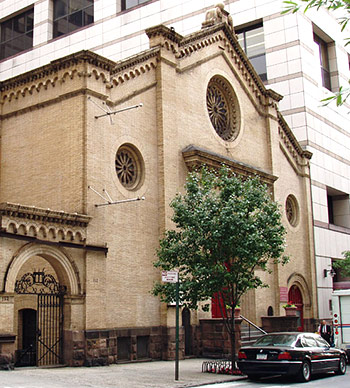
“one of the most refined and intelligent church spaces in New York” ~ The New York Times
Built in 1893 by Josiah Cleveland Cady, architect of the old Metropolitan Opera House and the American Museum of Natural History
|
Office Address:
JUPITER SYMPHONY
155 West 68th Street, Suite 319
New York, NY 10023
admin@jupitersymphony.com
(212) 799-1259
 
Like our Facebook page to see photos, videos,
concert information and the latest news
Jupiter in the News
ConcertoNet
“knocked the socks off this listener...It was wondrous chamber music. And the three artists gave it the deserving excitement, volition and imagination.”
Harry Rolnick, ConcertoNet more...

“the performers were top notch”
“The homey church where these concerts take place, nestled on West 66th Street in the shadow of Lincoln Center, is an intimate and acoustically vibrant place for chamber music.”
Anthony Tommasini, The New York Times more...
Strad Magazine
“A finely forthright, fluent and expressive account of Haydn's Divertimento in E-flat major opened this programme of miscellaneous chamber music in a series known for adventurous programming.”
Dennis Rooney, Strad Magazine more...
ConcertoNet
“Mr.
Nygaard’s cadenza flowed down Mozart lanes and paths, each with
beautiful backgrounds. And at the very end, Mr. Nygaard brought forth
that martial major theme, like an unexpected gift.”
Harry Rolnick, ConcertoNet more...
|
As promised, here are the videos of John Field’s Divertissement No. 1 and Sir Hamilton Harty’s Piano Quintet. Fortuitously, our Jupiter musicians had the good sense to record the rehearsal in an impromptu decision, literally minutes before pressing the record button. Pianist Mackenzie Melemed (replacing Roman Rabinovich at the last minute) learned the music in 2 days! Bravo to him.
Both works are Irish rarities that were scheduled for the March 16 performances which had to be canceled because of the coronavirus epidemic. Even though the entire program could not be recorded because of technical issues, we are pleased to be able to share with you the 2 musical gems. Enjoy.
John FIELD Divertissement No. 1 H. 13
~ simply delicious piano quintet, alternately titled Rondeau Pastoral and better known in its version for solo piano, Twelve O’clock Rondo, on account of the 12 “chimes” at the end ~ by the creator of the Nocturne, which had a major influence on Chopin
We thank the University of Illinois (Champaign) for a copy of the Divertissement music.
Mackenzie Melemed piano
Abigel Kralik violin
Dechopol Kowintaweewat violin
Sarah Sung viola
Christine Lamprea cello
Sir Hamilton HARTY Piano Quintet in F Major Op. 12
~ in a lyrical Romantic idiom, with a distinct, breezy Irish-salted voice
Andrew Clements of the Guardian proclaimed the beautiful Quintet “a real discovery: a big, bold statement full of striking melodic ideas and intriguing harmonic shifts, which adds Brahms and Dvořák into Harty’s stylistic mix, together with Tchaikovsky in some passages.” There’s folk music charm as well, reminiscent of Percy Grainger—notably in the Scherzo (Vivace) with its folksy quirks and nonchalance, and the winding, pentatonic melody in the Lento.
Our gratitude to the Queen’s University Library in Belfast, Northern Ireland, for a copy of the autograph manuscript of the music. Much thanks, too, to Connor Brown for speedily creating a printed score and parts from Harty’s manuscript.
Mackenzie Melemed piano
Abigel Kralik violin
Dechopol Kowintaweewat violin
Sarah Sun viola
Christine Lamprea cello
I Allegro 0:00
II Vivace 10:43
III Lento 14:44
IV Allegro con brio 23:59
|
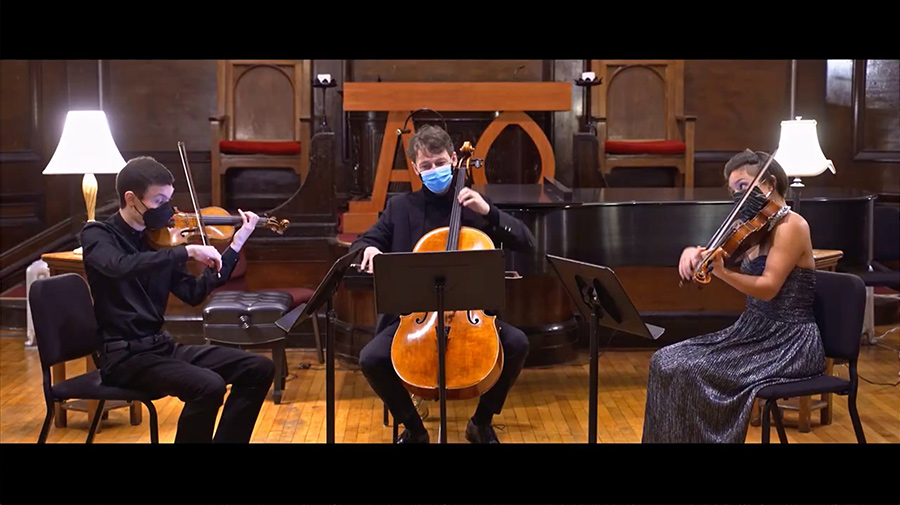
Oliver Neubauer violin, Mihai Marica cello, Zoe Martin-Doike viola
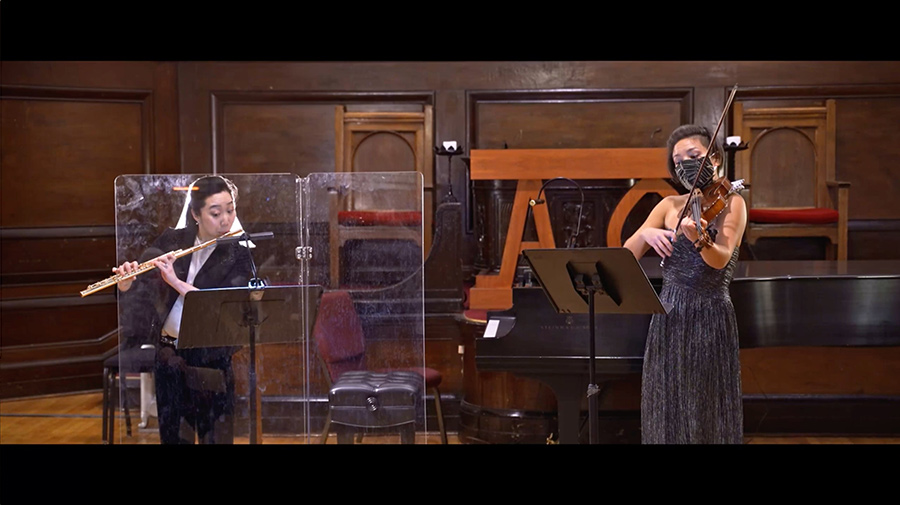
Sooyun Kim flute, Zoe Martin-Doike viola
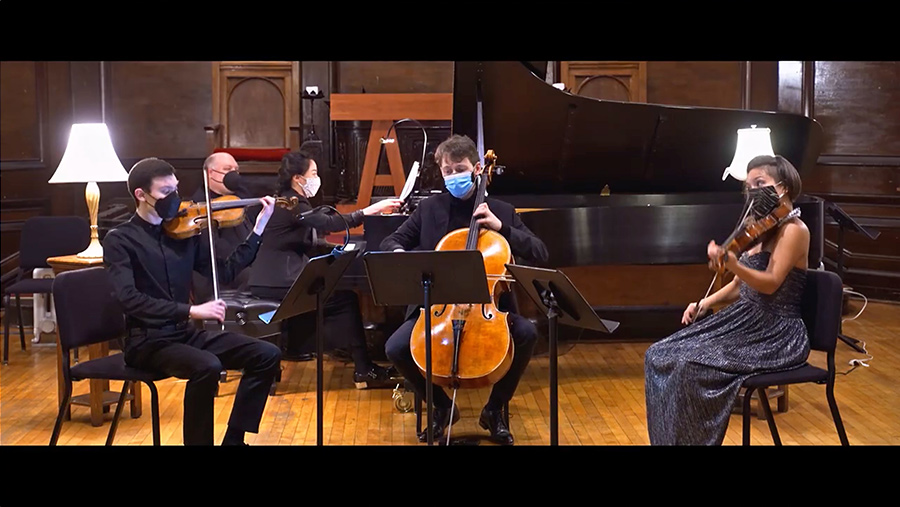
Oliver Neubauer violin, Janice Carissa piano
Mihai Marica cello, Zoe Martin-Doike viola
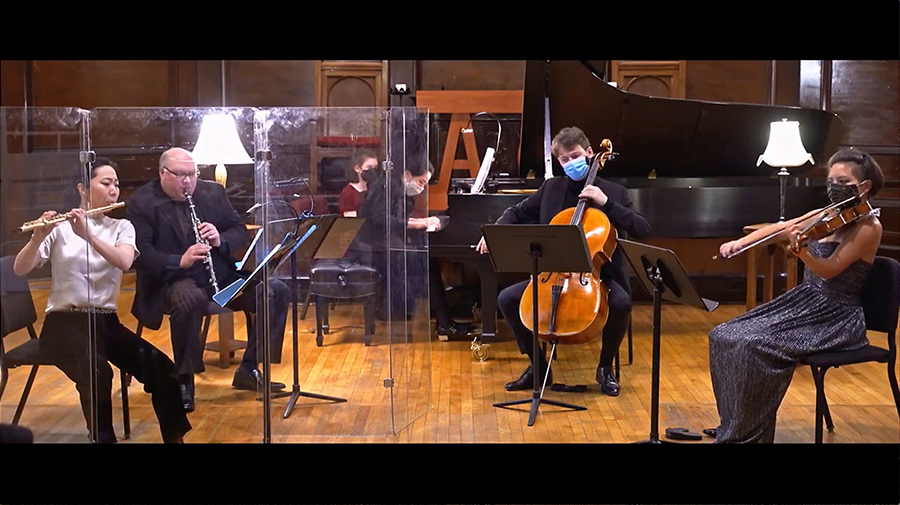
Sooyun Kim flute, Vadim Lando clarinet, Janice Carissa piano
Mihai Marica cello, Zoe Martin-Doike viola
|
Video Viewing ~ Classical Treats
February 8, 2021 Jupiter Concert
Greetings! Three months ago, our musicians brought warmth and joy with their wonderful music making on a cold, winter’s day with Classical Treats. The viewing is offered for $25, and we hope to cover the costs of production. Thanks so much for viewing the video of this concert, and for supporting Jupiter with gifts as well! MeiYing
View the video for $25
You will be automatically directed to the video page once payment is made. If not, click on the “return to merchant” link after checkout. Please go through the checkout process only once and do not use the back button or reload the page while making the purchase. If there are any problems, contact jupiternews@jupitersymphony.com.
Viewers comments of previous videos:
“Oh I thoroughly enjoyed the concert. Good to see Maxim and his dad. Familiar faces to me. I enjoyed the notes about the players. Till the next time...”
“Great playing and really nice camera work. Probably better than being there!”
“We so enjoyed the concert. The pianist was outstanding as was the musical selection.”
“It was wonderful. Thank you.”
♦ ♦ ♦
Musicians
Janice Carissa piano
Young Scholar of the Lang Lang Foundation, recipient of the 2018 Salon de Virtuosi Grant, winner of the 2014 piano competition at the Aspen Festival, and a top prizewinner of the IBLA Foundation’s 2006 piano competition (at age 8)
Oliver Neubauer violin
Recipient of the Gold Award at the 2018 National YoungArts Competition and winner of the 2017 Young Musicians Competition at the Chamber Music Society of Lincoln Center
Zoë Martin-Doike viola
Member of the Metropolitan Opera Orchestra, top prizewinner of the Primrose and Lenox competitions on viola and violin, respectively and founding violinist of the Aizuri Quartet
Mihai Marica cello
Winner of the Irving Klein, Viña del Mar, Salon de Virtuosi and Dotzauer competitions ~ “Mihai is a brilliant cellist and interpreter of music. His playing is spellbinding.” Mitchell Sardou Klein
Sooyun Kim flute
Winner of the Georg Solti Foundation Career Grant and a top prize at the ARD flute competition, she has been praised for her “vivid tone colors” by the Oregonian and as a “rare virtuoso of the flute” by Libération
Vadim Lando clarinet
Winner of the CMC Canada, Yale and Stonybrook competitions ~ “consistently
distinguished...vibrant, precise, virtuosic playing” The New York Times
♦ ♦ ♦
Program
HAYDN Sonata No. 1 in G Major Hob XVI:40 ▪ 1784
~ sophisticated and subtly wrought, the Sonata is from a set of 3, arranged for string trio from the original for keyboard and published by Johann André in 1790
The sonatas were written for Princess Marie, the new bride of Prince Nicholas Esterházy, grandson of Haydn’s employer, Prince Nicholas I. Cramer’s Magazin der Musik, in its review in 1785, observed that they were “more difficult to perform than one initially believes. They demand the utmost precision, and much delicacy in performance.” In 2 contrasting movements, the pastoral Allegretto innocente is followed by a gleeful zany romp.
Conradin KREUTZER Quintet in A Major ▪ between 1810 and 1820
~ in the late Classical–early Romantic style, the charming Quintet is written for the unusual combination of piano, flute, clarinet, viola, and cello with the piano as primus inter pares, first among equals—each movement a winner bearing a variety of melodic gifts and revealing a lively feeling for rhythm and color
Born in Messkirch to a respected Swabian burgher, Kreutzer (1780–1849) is considered a minor master of the Biedermeier epoch. He studied law in Freiburg before turning entirely to music after his father died in 1800. In 1804 he went to Vienna, where he met Haydn and probably studied with Albrechtsberger, one of Beethoven’s teachers. His active career included tours in Europe and several posts in Vienna, Stuttgart, Cologne, and other German cities, all the while composing numerous operas. Some of his music is not entirely forgotten—his settings for male chorus to Ludwig Uhland’s poems long remained popular with German and Austrian choirs; Das Nachtlager in Granada used to be revived occasionally in Germany; and his score for Der Verschwender continues to be performed in Austria.
Franz Anton HOFFMEISTER Duo Concertante No. 1 in G Major ▪ [1790]
flute and viola
1st movement ~ Allegro
~ by Mozart’s friend and his principal publisher
MOZART Piano Quartet No. 2 in Eb Major K. 493 ▪ 1786
~ a flawless masterpiece of utmost lightness and charm, with heavenly melodies
Mozart was under contract with the publisher Franz Anton Hoffmeister to write 3 piano quartets, a virtually new genre of his own invention. When the first (K. 478 in G minor) did not sell because of its difficulty for amateurs, Mozart was released from his obligation. Nine months later, which was two months after the completion of Le Nozze di Figaro, the second piano quartet (K. 493 in Eb Major) was published by Artaria. A little easier than the first, Alfred Einstein viewed it as “bright in color, but iridescent, with hints of darker shades.”
♦ ♦ ♦
Harry Munz audio engineer
Marc Basch videographer
For more about the musicians: guest artists • players
For further notes on the music: calendar |
|
